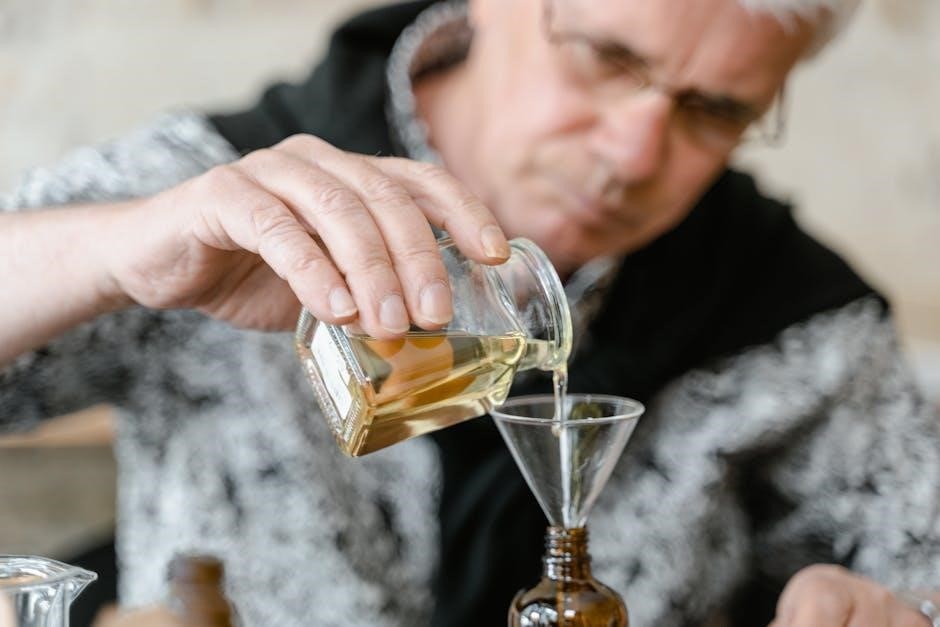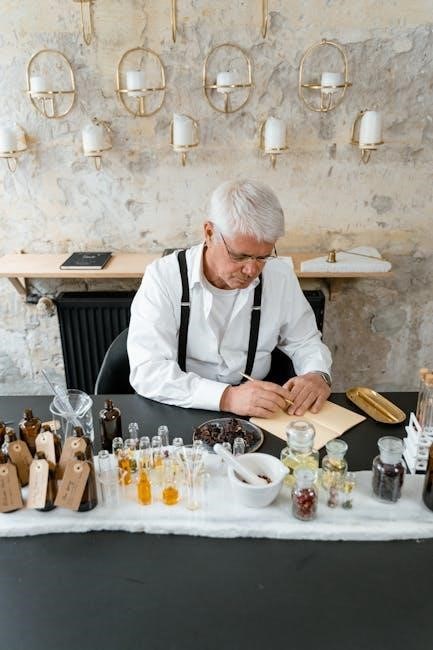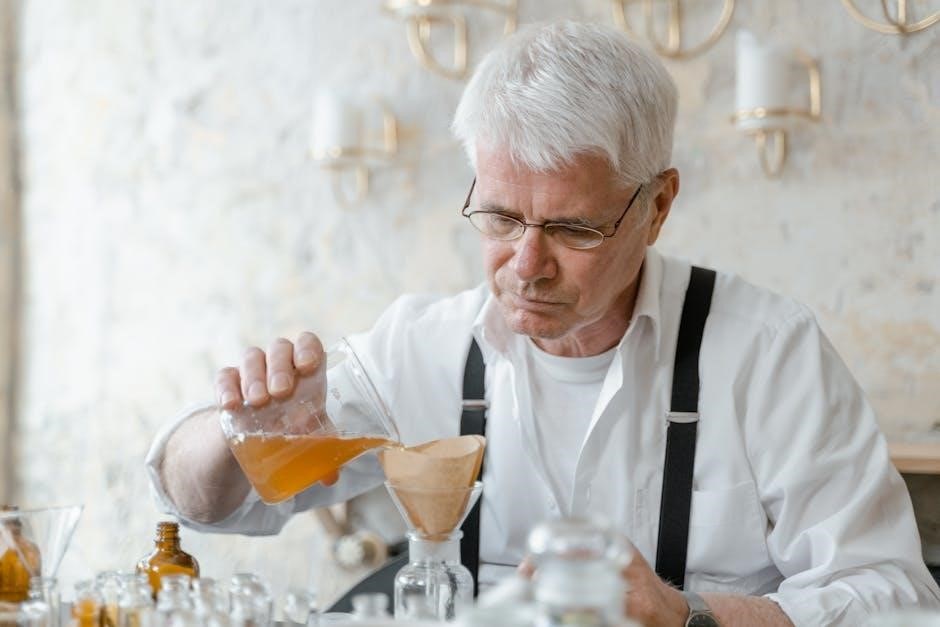Perfume concentration refers to the ratio of fragrance oils to alcohol or water‚ determining scent longevity and intensity. Understanding this helps choose the right fragrance for any occasion.
What is Perfume Concentration?
Perfume concentration refers to the percentage of fragrance oils in a perfume‚ determining its strength‚ longevity‚ and projection. Higher concentrations mean more fragrance oil‚ resulting in a stronger‚ longer-lasting scent. This ratio of essential oils to alcohol or water defines the intensity and duration of the fragrance. Understanding concentration levels helps consumers choose the right scent for their preferences and occasions‚ ensuring optimal performance and enjoyment.
Why Understanding Concentration Matters
Understanding perfume concentration is crucial for selecting a fragrance that suits your lifestyle and preferences. Higher concentrations last longer but may be overpowering‚ while lighter ones are subtle and short-lived. Knowing the differences helps in making informed decisions‚ ensuring the chosen scent aligns with personal taste‚ occasion‚ and environmental factors. This knowledge enhances the overall fragrance experience‚ offering a balance between intensity and longevity.

Understanding Perfume Concentration Levels
Perfume concentration levels vary‚ ranging from Parfum to Eau Fraiche‚ each differing in fragrance oil content‚ longevity‚ and intensity‚ impacting the scent’s duration and strength.
Parfum (Extrait de Parfum): 20-40% Essence
Parfum‚ or Extrait de Parfum‚ is the most concentrated fragrance‚ containing 20-40% essence. It offers intense longevity‚ typically lasting over eight hours‚ and a rich‚ complex scent. Due to its high concentration‚ it’s often used sparingly‚ applied to pulse points for a subtle yet enduring aroma. This luxurious option is ideal for special occasions and those who prefer a strong‚ lingering fragrance. Its potency makes it a premium choice in perfumery.
Eau de Parfum (EDP): 15-25% Essence
Eau de Parfum (EDP) contains 15-25% fragrance essence‚ offering a balanced blend of longevity and scent projection. It typically lasts 4-8 hours‚ making it ideal for everyday use. The middle notes are more pronounced‚ providing a stronger aroma compared to Eau de Toilette. While it may not project as much as EDT‚ its longevity on the skin is superior. EDP is a popular choice for its robust yet refined scent‚ suitable for various occasions without being overpowering.
Eau de Toilette (EDT): 5-15% Essence
Eau de Toilette (EDT) holds 5-15% fragrance essence‚ offering a lighter and fresher scent. It typically lasts 2-4 hours‚ making it perfect for casual‚ daytime use. EDTs are often more affordable and versatile‚ suitable for everyday wear. Their lower concentration means they don’t linger as long as EDPs but provide a subtle aroma. This makes EDT ideal for those who prefer a delicate fragrance without overwhelming intensity‚ ensuring a fresh and clean feel throughout the day.
Eau de Cologne (EDC): 2-5% Essence
Eau de Cologne (EDC) contains 2-5% fragrance essence‚ making it one of the lightest concentrations. It offers a fresh‚ citrusy scent that typically lasts 2 hours or less. EDCs are often used for quick refreshment and are ideal for everyday use‚ especially during warmer seasons. Unlike other concentrations‚ EDCs usually contain a higher alcohol content‚ which can be invigorating but may not last long on the skin. This makes them perfect for those who prefer a subtle‚ revitalizing aroma without strong longevity.

Eau Fraiche: 1-3% Essence
Eau Fraiche is a very light fragrance with a concentration of 1-3% essence‚ often used for its refreshing and subtle aroma. It typically does not contain alcohol and is composed of water and fragrance oils‚ making it gentle on the skin. Eau Fraiche is ideal for everyday use‚ particularly in hot weather‚ as it provides a gentle‚ cooling effect. However‚ its low concentration means it fades quickly‚ lasting no more than 2 hours‚ requiring frequent reapplication for sustained scent.

How Concentration Affects Fragrance Performance
Fragrance concentration directly impacts longevity‚ intensity‚ and projection. Higher concentrations last longer and emit a stronger scent‚ while lower concentrations fade faster but are lighter.
Longevity: How Long a Fragrance Lasts
The longevity of a fragrance depends on its concentration‚ with higher concentrations lasting significantly longer. Parfum‚ at 20-40%‚ can persist for 8 hours or more‚ while Eau Fraiche‚ at 1-3%‚ fades within 2 hours. Eau de Parfum (15-25%) typically lasts 6-8 hours‚ Eau de Toilette (5-15%) lasts 4-6 hours‚ and Eau de Cologne (2-5%) remains for 2-4 hours. Skin type and application method also influence longevity‚ making it vary from person to person.
Strength and Intensity of the Scent
The strength and intensity of a fragrance are directly tied to its concentration. Higher concentrations‚ like Parfum (20-40%)‚ deliver bold‚ intense scents‚ while lower ones‚ such as Eau Fraiche (1-3%)‚ offer lighter‚ more subtle aromas. The potency of the fragrance oil determines how noticeable the scent is and how it evolves over time. Stronger concentrations are often preferred for evening wear or special occasions‚ while lighter ones suit everyday use‚ catering to personal preference and sensory sensitivity.
Scent Projection and Radius
Scent projection refers to how far a fragrance diffuses from the wearer‚ while radius measures how widely the scent is perceived. Higher concentrations‚ like Parfum‚ project strongly but may not linger as long in terms of radius. Lower concentrations‚ such as Eau de Toilette‚ often have a wider radius but less intensity. The balance between projection and radius varies with concentration‚ influencing how others perceive the scent in different settings and environments‚ making it a key factor in fragrance selection and personal impact.
Choosing the Right Concentration

Selecting the ideal fragrance concentration depends on personal preferences‚ occasion‚ and lifestyle. Higher concentrations suit special events‚ while lighter ones are perfect for everyday use‚ ensuring the perfect balance of scent longevity and subtlety.
Factors to Consider: Personal Preference and Occasion
Personal preference and occasion play a crucial role in selecting fragrance concentration. For instance‚ lighter concentrations like Eau Fraiche or Eau de Cologne are ideal for casual‚ daytime events‚ offering a subtle and refreshing scent. In contrast‚ higher concentrations such as Parfum or Eau de Parfum are better suited for formal events or evening wear‚ as they provide a richer‚ longer-lasting aroma. Additionally‚ personal lifestyle factors‚ such as work environment or activity level‚ can influence the choice of fragrance concentration. For example‚ someone with an active lifestyle may prefer a lighter‚ less overpowering scent‚ while others might opt for a stronger fragrance that lasts throughout the day. Understanding these factors helps in making informed decisions to ensure the fragrance complements both the occasion and individual preferences effectively. Balancing personal taste with situational needs ensures the perfect match‚ enhancing the overall experience of wearing perfume.
Seasonal Variations in Fragrance Choice
Seasonal changes often influence fragrance preferences and concentration choices. In warmer months‚ lighter concentrations like Eau de Cologne or Eau Fraiche are favored for their refreshing‚ subtle scents. Conversely‚ cooler seasons call for richer‚ warmer fragrances with higher concentrations‚ such as Parfum or Eau de Parfum‚ which offer deeper notes and longer longevity. Personal preference also plays a role‚ as some prefer citrus scents in summer and spicy notes in winter. Seasonal variations in fragrance choice ensure the scent complements the environment and mood‚ enhancing overall wearability and appeal.
Skin Type and Its Impact on Fragrance Longevity
Skin type significantly influences how long a fragrance lasts. Oily skin tends to retain scents longer due to its natural moisture‚ making lower concentrations like Eau de Toilette effective. Dry skin may benefit from richer concentrations such as Eau de Parfum or Parfum‚ as they linger more. Normal or combination skin adapts well to most concentrations‚ while sensitive skin may prefer lighter options. Understanding skin type helps optimize fragrance longevity and ensures a pleasant wear experience throughout the day.
Application Tips for Different Concentrations
Apply concentrated fragrances sparingly‚ focusing on pulse points. Lighter concentrations may require reapplication. Balance usage to ensure optimal scent projection and longevity throughout the day.
Techniques for Applying Concentrated Fragrances
For concentrated fragrances like Parfum or Eau de Parfum‚ apply a small amount to pulse points such as wrists‚ neck‚ and behind the ears. Gently dab‚ avoiding rubbing‚ to preserve fragrance integrity. These methods enhance longevity and prevent overpowering others. Apply after moisturizing for better absorption and a more even scent diffusion throughout the day. This ensures the fragrance unfolds naturally‚ maintaining its complexity and depth effectively.
Best Practices for Layering Scents
Layering scents involves combining fragrances to create a unique aroma. Start with a base note‚ such as a rich Parfum‚ then add a middle note like Eau de Parfum‚ and finish with a light Eau de Toilette. This technique enhances depth and longevity. Use complementary scents‚ such as floral and woody notes‚ to avoid clashing. Apply each layer sparingly to pulse points‚ allowing time for absorption between applications. This approach creates a complex‚ personalized fragrance profile that lasts throughout the day.
Understanding perfume concentration is key to selecting the perfect fragrance. Higher concentrations last longer but may be overpowering‚ while lighter ones offer freshness without intensity. Choose wisely based on personal preferences and occasions for an optimal scent experience.
Perfume concentration determines the strength and longevity of a fragrance‚ ranging from Parfum (20-40% essence) to Eau Fraiche (1-3%). Higher concentrations last longer and are more intense‚ while lighter ones provide a subtle‚ fresh scent. Understanding these levels helps in selecting the right fragrance for personal preferences‚ occasions‚ and skin types‚ ensuring a perfect balance between scent intensity and duration. This knowledge empowers users to make informed choices for everyday use or special events.
Final Tips for Selecting the Perfect Fragrance Concentration
Consider personal preferences‚ occasion‚ and season when choosing fragrance concentration. Test samples on skin to gauge longevity and intensity. Higher concentrations like Parfum are ideal for special events‚ while lighter options suit daily use. Layering scents can enhance complexity. Skin type affects fragrance longevity‚ so adjust accordingly. Experiment with different concentrations to find your perfect match‚ ensuring confidence and satisfaction with your scent choice.
